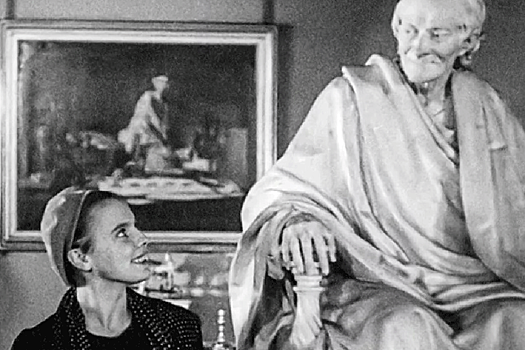Picasso in the archives of the gendarmerie. Eight new books about art
The artistic life of Moscow in the 1960s, the best-selling book about the life of Van Gogh, Picasso in the archives of the Paris gendarmerie, how museums told about them at the beginning of the twentieth century, history art with and without the quadrilateral code – in a new book collection of the GodLiterature.RF column.

Leonid Talochkin. “Tomorrow – see you again yesterday”
Garage Museum of Contemporary Art Publishing Program
The name of collector, researcher and archivist Leonid Talochkin is still not as well known to the public as the name of the already legendary George Costakis. Although in terms of contribution to the history of Russian art, they can be ranked on the same level: Costakis preserved and saved avant-garde art, Talochkin – the unofficial art of the 1960s-70s, later named nonconformism. However, the history of understanding the contribution of the half-educated engineer and former elevator operator has been going on at various establishments for several years now. First of all, at the Tretykov Gallery, where his widow donated a huge collection of works, including Oscar Rabin, Evgeny Kropivnitsky, Vladimir Nemukhin and Dmitry Plavinsky. On the other hand, in the Garage Museum of Contemporary Art, Talochkin's huge archive with diaries, photos, letters and other things is stored. Through the efforts of both museums, several years ago a complete catalog of the collector's gift to the Tretykov Gallery was published, and now a large volume of documentary evidence about the artistic life of Moscow in the 1960s was published.
Stephen knife. “Van Gogh's search for himself: inspiration and discovery”
Publishing house “Bombora”
Back in 2019, ABC Publishing published a two-volume book by Pulitzer Prize winners Steven Nayfe and Gregory White-Smith called “Van Gogh. A Life”, is on the international bestseller list in many countries. To write it, the art-loving lawyer duo spent more than a decade researching. After his co-author's death in 2014, Nayfi released another monograph on Van Gogh seven years later, but focusing on his relationships with other artists, from Rembrandt to Renoir and Monet.
Annie Cohen-Solal. “Picasso. Foreigner. Life in France 1900-1973”
Publishing house “Colibri”
This book could become another biography of the most famous artist of the 20th century, of which dozens have already been published. But researcher and writer Cohen-Solal decided to counter the story with her own discoveries about the life of the “stranger”, made in the archives of the Paris gendarmerie. And although many facts are known to one degree or another from the memoirs of Picasso himself and his contemporaries, some unpleasant details that often remained in the shadows, but are now coming to light. face. For example, about the artist's miserable and helpless existence during his early years in France, where the Spaniards remained almost on an equal footing with the Algerian refugees. About the constant surveillance and surveillance by the police and the refusal to naturalize. About the fact that both the Paris institution and the museums ignored the invention of cubism and Picasso's innovative methods in general (in 1929, the Louvre refused to accept the gift of “Les Demoiselles d' Avignon” (his iconic name).
Andrey Efits. “”Viewers, be active!” How museums talk about art of the 1920s-1930s”
Garage Museum of Contemporary Art Publishing Program
This is a large-scale study of the nearly century-long history of the eradication of museum snobbery and the transformation of the world's greatest institutions toward audiences. Drawing on hundreds of books, articles, memoirs and archives, art historian Andrei Efits shows how things that are comfortable and entertaining for people today became popular again. appears in museums. From wardrobes, hall benches and explanatory notes to children's studios, cafes, film screenings, lectures and master classes. The starting point for this restructuring was the International Congress of the History of Art in Paris in 1921, where the concept of a truly “living” museum was first conceived.
Irina Volkova, Marina Ivanova. “Facial Art. Portraits of the ages from primitive times to the present day”
Publishing house “Bombora”
Historical background, works of art from different eras, peoples and their authors – this is what the narrative of this quasi-Wikipedia publication is built on. Its editors, Irina Volkova and Marina Ivanova, are university teachers: this is probably why the book reads like a collection of lectures or a textbook on the history of summary art , equipped with suitable illustrations. However, the book also has a “revival” element: before publication, the author recorded a series of podcasts with expert guests, and before each chapter there is a copyright code with a free listening link.
Jessica Hemmings. Iris van Herpen: rethinking fashion
VAC press publisher
Dutch designer Iris van Herpen opened her own fashion house in 2007 and just four years later, she began showing couture collections in Paris. Fashion historians say her works were created at the intersection of design, architecture and art, which is why leading museums around the world are ready to display them. them: for example, earlier this year, beautiful sculptural dresses surrounded by works by contemporary artists were displayed at the exhibition. Museum of Decorative Arts in Paris.
British researcher Jessica Hemmings in her new book describes the stages of the designer's development, her creative approach to clothes and sources of inspiration.
Antonio Paolucci. “Italian Art. 1000 years of history”
Publishing house “Slovo”
With the book by former director of the Vatican Museums Antonio Paolucci, first published in Italy in 2006, the publisher opens a new encyclopedia on the culture of different countries of the world. In a luxuriously illustrated publication, one of the leading experts on Renaissance art has actually tried – and quite interestingly – to capture the immensity that thousands of books have been written about – Italian art from antiquity to the early 21st century. From the masterpieces of the anonymous sculptors Giotto and Paolo Uccello to Giorgio Morandi and the works of the legendary povera art movement and beyond contemporary works. The series will continue this year with the release of books about the cultures of India, China and Russia.
Moshe Safdie. “If walls could talk… My life is architecture”
Publishing house “Colibri”
Among Israeli architect Moshe Safdie's memorable buildings are the airport and science and arts museum in Singapore, the Holocaust History Museum in Jerusalem, modular homes in Montreal, the Museum of American Art Crystal Bridges in Arkansas and many other buildings. Last year, the living classic turned 85 years old and the release of his autobiography was timed to coincide with the day. The book is an almost intimate diary of dreams, disappointments and decisions as well as the history of the making of modern architecture, even a kind of guide for architects Ambitious colleagues about today's ways and methods of working individually and in groups.




Leave a Reply